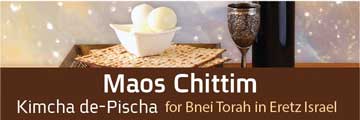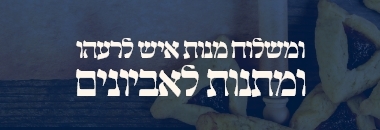Kavod hameis, showing proper respect for the deceased, has always been a deeply-rooted tradition within the Jewish people.
In halachah, this concept finds its expression in many laws, such as in laws against autopsy (see Chasam Sofer, Yoreh De’ah 336);in the requirement of a speedy burial (Yoreh De’ah 357:1); in the waiver of various rabbinic restrictions on Shabbos and Yom Tov to ensure proper care of the dead (Orach Chaim 311, 526); in the rituals of taharah (bathing the body) and tachrichim (dressing it in shrouds; see Chochmas Adam 157:8); in various laws concerning the respect that must be shown in a cemetery and what activities therein are prohibited (see Yoreh De’ah 364, 368); and in various practices that are banned because of lo’eg lerosh (“mocking the helpless”—see, for instance, Yoreh De’ah 367:2 and Orach Chaim 45:1, where walking with tefillin in proximity to a grave is forbidden).
This week, we will address another halachic issue that pertains to the honor of the deceased: the question of removal and excavation of corpses or bones. Although the matter of disinterment of graves has of late reached the headlines of the Israeli media, the issue is by no means new, and ever since the modern development of the land began (some hundred years ago), serious questions over the relocation of graves have arisen.
Regretfully, the governmental authorities have, on the whole, treated the matter of disinterment with disdain and disrespect, and graves have been casually uprooted for almost any reason (including archeology, various matters of research, road building, establishing shopping centers, and so on). In recent years, religious opposition to the desecration of graves has gained momentum, and the issue has reached the public eye, becoming a significant bone of contention in the already strained relations between religious and secular Jews in Israel.
Before we make our protests, however, it is important to understand the prohibition of desecrating or disinterring graves, and knowing its parameters. What is the nature of the prohibition, and when it is it permitted to disinter graves? Is it permitted to relocate a grave for the purpose of some communal need, and to what degree must resources be spent to avoid such action? This article will seek to resolve these questions (to some degree), and to clarify the delicate issue of dealing with Jewish graves.
The Prohibition of Excavating a Grave
Under ordinary circumstances, halachah sharply condemns the excavation and removal of corpses from their gravesites, even when they will be reburied elsewhere.
Based on the verse, “The hand of Hashem will strike against you and your fathers” (I Shmuel 12:15), Chazal (Yevamos 63b) state that “due to the sins of the living, the dead are tampered with.” Clearly, the “tampering with” or desecration of remains is considered an evil decree, and badly affects the deceased. Because the evils of the live are reflected in the suffering of the dead, the Shevus Yaakov (Vol. 2, no. 103) writes that desecration of remains of the dead is cause for decreeing a public fast, to protect from danger that might result (he ruled that an entire community should fast after a local cemetery was desecrated by local vandals).
The hardship that caused to the dead is the reason, according to the Be’er Heitev (Yoreh De’ah 363:1) for the prohibition on exhuming remains, as ruled by the Shulchan Aruch: “It is forbidden to inter the dead and bones.”
The Shulchan Aruch stresses that the prohibition applies even if the dead is being relocated to a grave that affords him greater honor—the added honor does not offset the damage of relocation in itself. This ruling is reflected in a reponsum of Rav Moshe Feinstein (Iggros Moshe, Yoreh De’ah 2:162), who prohibited the relocation of a corpse to a local graveyard, where family will be able to visit (although some poskim cite this consideration as grounds for leniency; see Seridei Eish, Vol. 2, no. 100, for a lengthy discussion of the matter).
Authorities discuss the precise nature of the “hardship” involved in the excavation of remains. According to one suggested reason, excavation causes the souls of the deceased to be filled with terror and trepidation (charada), since they believe they are being summoned to Divine judgment (Taz and Shach 363:1). According to this explanation, Rav Dovid Oppenheimer (responsum printed at the end of Shut Chavas Yair) writes that the prohibition is of rabbinic nature.
An added reason is that the excavation of remains is an act of desecration and humiliation of the dead (nivul u’bizayon hameis), akin to autopsies, cremation, and the like. The prohibition of nivul hameis is mentioned by the Gemara (Bava Basra 154a), and some write (cited in Tzitz Eliezer, op. cit. sec. 4) that this is even a Torah prohibition. The Chacham Tzvi (47, 50) writes that this is the preeminent reason for the prohibition, and therefore rules that it is preferable to move the coffin than to expose the body (because the issue of desecration takes precedence over the issue of the deceased’s trepidation).
It is noteworthy that according to the Noda Biyhuda (Tinyana 89) the prohibition of interring a grave does not apply to bones alone, and only to remains that include flesh (see also Gesher Hachaim Chap. 26, 1:10). Most authorities, however, do not accept this distinction, as the Yerushalmi (Mo’ed Katan 2:4) states, “one may not exhume the dead and the bones.” Moreover, as Rabbi Waldenberg notes, even the Noda Biyhuda does not give a general permit to inter bones, and only permits doing so under extenuating circumstances, and under threat of severe desecration.
Reasons for Relocating a Grave
Several exceptions to the prohibition are mentioned by the Shulchan Aruch (Yoreh De’ah 363:1). It is permitted to excavate and remove remains for the following reasons:
- If they were buried there without the permission of the landowner. Under such circumstances, it is a mitzvah to do so (see also Birkei Yosef 363).
- If the grave and remains are likely to be damaged by water or sewage backups, by vandalism, and so on, and there are no alternatives to removal that could solve the problem. This was the reason given by Rav Ovadyah Yosef (Yalkut Yosef, Aveilus 32:9) concerning relocating graves in territories that had been returned to Egypt under the Camp David accords.
- If the person was buried in one place with the specific intention of later removing his remains to a different site.
- If the person is being relocated to the Land of Israel, or to the family burial plot (kever avos). See Iggros Moshe (Yoreh De’ah Vol. 3, no. 153), who writes that decisions of relocation the grave can only be taken by the children of the deceased, and not by the general Jewish community.
Another reason for permitting the the relocation of a grave is if the current positioning causes damage to other graves (see Eretz Chaim, Yoreh De’ah 364). As noted above, some poskim are willing to permit removal not only to the family burial site, but even to places where surviving children and relatives can come to pray or visit.
Graves that Cause Public Damage
There is, however, an additional exception that may be invoked, which is the focal point of the contemporary discussion over relocation of graves. The Shulchan Aruch (Yoreh De’ah 364:5) rules that a grave which causes damage to the public may be removed. Such a grave may be removed even if the burial took place with the consent of the owner of the property.
We learn from this halachah that the imperatives of kevod hameis yield when they unduly restrict the rights of the public to access and use of the property. Although Rav Moshe (Iggros Moshe, Yoreh De’ah 3, no. 151) writes that there is room to distinguish between a single grave and an entire cemetery, most poskim make clear that the law permitting relocation applies not only to a single grave, but even to an entire cemetery (Rav David Oppenheim, cited in end of Shut Chavos Yeir; Shut Rabbi Akiva Eiger, no. 45).
The two sources just mentioned explain further that the permission of excavating remains that cause damage to the public applies even to “communal needs.” Rav David Oppenheim, whose responsum is cited by Rabbi Akiva Eiger, discusses the relocation of graves for the purpose of rebuilding a dilapidated shul. In his opinion, the need of disinterring the remains fits the model of “graves that cause damage to the public,” and it is therefore permitted to relocate them.
Clearly, a major question is determining what classifies as a true “public need,” and what does not. Some cases are fairly clear cut. For instance, a need to construct new access roads to link Jewish settlements in Jerusalem, thereby avoiding dangerous passage through Palestinian-controlled territory, would permit the disinterment of graves if no other option was available. However, can the same be said of excavating sites to yield archaeological information? Is ignorance damage? Does the same logic apply to construction of apartment blocks and shopping centers?
Clearly, the application of the halachah will depend greatly on the approach of the particular posek. Some authorities, such as Rabbi Shaul Yisraeli (Chavas Binyamin 25:5), give a broad definition to the concept of “public damage,” including even such issues as the beauty of the land of Israel. However, the great majority of poskim place tight constrictions on the category, and are unwilling to include anything that is not a clear-cut communal need.
Incurring Great Expenses
In most cases, it is possible to avoid the disinterment of graves by formulating alternative construction plans. Bridges can be formed for roads, buildings can be moved, and neighborhoods re-planned. These changes often involve great cost, and the question is to which degree is there an obligation to incur costs to avoid the excavation and interment of graves.
The Rema (Yoreh De’ah 368:1), based on the Terumas Hadeshen (284), rules that there is no obligation to lay out great expenses for the purposes of preventing the local ruler from bringing in his horses to the cemetery: “If the community can afford it, and they can protest [the practice] by incurring a small expense, they have to protest, provided there is no risk that the ruler will be incited against them. However, if this is not the case, there is no need to protest.”
Yet, Shut Shivas Tzion (62-63), also addressing the plans of a local ruler to build a road through a cemetery, rules that the community must go to great lengths to avoid this, even if it involves incurring great expenses. Only if the expenses are too great, so that they cannot be borne by the community, is it permitted to relocate the graves. In siman 63, Shivas Tzion rules that the community must incur great expenses even to avoid the transfer of the cemetery to control of the local ruler.
Concerning the apparent leniency of the Rema, Shivas Tzios explains that the Rema was referring to a lesser form of desecration, for which laying out great expenses was unjustified. Alternatively, he writes that the Rema was only lenient due to the concern that the non-Jewish ruled would take the cemetery into his jurisdiction, which would lead to a serious desecration of the graves.
Certain authorities, such as the Rebbe of Munkatch (Minchas Elazar, Yoreh De’ah 34), cite the responsum in obligating the preservation of graves almost at all costs.
However, the Chasam Sofer (Yoreh De’ah 334) seems to take a somewhat different approach. Although there is room to distinguish between the cases (in the case of the Chasam Sofer there is another reason to uproot the cemetery), he rules that there is no obligation of incurring great expenses to prevent the desecration of graves, and recommends their relocation: “It is simple that it is permitted and a mitzvah to make efforts in this matter… although it is forbidden to relocate a grave, this case is different, because the graves are not surrounded by a perimeter fence, and it is likely that the cemetery will be desecrated. Although great expenses… may bring the rulers to build a wall around the graveyard… but who can place such a burden on the community… and in such cases it is permitted to relocate the graves.”
Additional Considerations
We will not discuss, in this context, the prohibition of deriving benefit from the deceased and from graves, and leave the discussion for future opportunity.
Before ending, however, it is important to mention an additional consideration that weighs against the relocation of graves, even when doing so might be halachically permitted. As many poskim have noted, the excavation of Jewish graves by Jews raises a concern that other countries will feel that they, too, are able to freely excavate Jewish graves, and will no longer show any sympathy to the cause of Jews who protest such excavations.
Rav Moshe (Iggros Moshe, Yoreh De’ah Vol. 3, no. 151) raised this concern with regard to a question of selling a London cemetery and relocating the remains in Israel: “For relocating graves at the hands of Jews will bring a pitfall in that many cemeteries will be forcefully seized, and there will be no way of protesting on grounds that it is forbidden, for Jews themselves have sold their own ancient cemeteries. They [the non-Jews] will not distinguish between Israel and chutz la-aretz.” The concern is reiterated a number of times in Shut Seridei Eish (relying on personal experience), and is mentioned as long ago as the Chasam Sofer (Vol. 6, no. 37).
Conclusion
Shortly after World War I, Rabbi Yechiel Yaakov Weinberg was asked about the halachic permissibility of disinterring the remains of Jews buried in Poland for reburial in Germany (there was great concern that the Jewish cemetery would be desecrated). In conclusion of this article, it is worth quoting the preface to his halachic analysis (Shut Seridei Eish, Vol. 2, no. 100):
The removal of bones from one gravesite to another … is a matter that our rabbis and decisors in all generations have treated with great severity, for we find that Chazal were very insistent on the proper respect to be paid to the dead…. And therefore we observe that time after time when a question concerning the disinterment of bones came before the great masters, they would apply themselves to this halachah with great gravity and seriousness, and they would preoccupy themselves in the clarification and meticulous examination of all possibilities, and they would not rush to permit even under circumstances where the basis for leniency was clear and obvious. It is well known how the gedolei hador were filled with fear and trepidation when they had to decide whether to permit the disinterment of the pure body of the Gaon Rabbi Mordechai Benet from Lichtenstaut to Prague.
Although we cannot decide a priori that every case of disinterment is prohibited, our dealings with the deceased obligate a special measure of gravity and seriousness. Generalities should be avoided, and every case must be analyzed, based on individual circumstances, with meticulousness and care.










